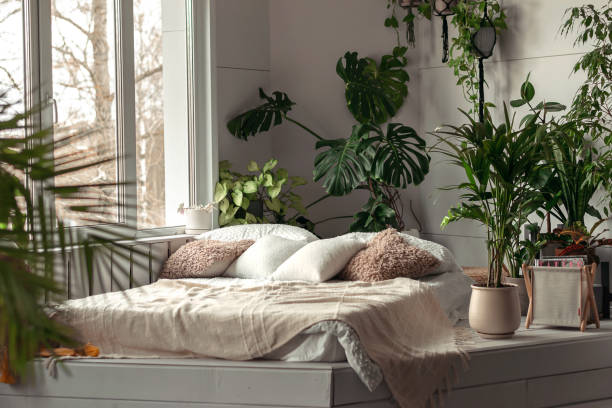Introduction
Do you ever wonder why your once-lush houseplants seem to wither away despite your best efforts? Picture this: you’ve carefully chosen the perfect pots, diligently watered them, and even sung a serenade or two, yet they still look lackluster. What could be missing from this green equation? Well, my friend, the answer lies in the often overlooked but critical element of lighting :Houseplant Lighting .
Imagine this scenario: you’ve painstakingly curated your indoor oasis, only to find your beloved plants drooping and fading away before your eyes. It’s a disheartening sight, isn’t it? But fear not, for we’ve been there too. As seasoned plant enthusiasts with a shared passion for nurturing nature indoors, we understand the frustrations that come with struggling houseplants. And let us tell you, the solution isn’t always as straightforward as it seems.
With years of trial and error under our belt, we’ve uncovered the secrets to cultivating thriving indoor gardens. From battling the perils of insufficient sunlight to mastering the art of artificial lighting, we’ve navigated the murky waters of plant care with both triumphs and tribulations. And now, armed with our hard-earned wisdom and expertise, we’re here to guide you through the maze of houseplant lighting.
So, if you’re tired of watching your plants wilt away and yearn to see them flourish in all their verdant glory, you’re in the right place. Buckle up, fellow plant parent, because we’re about to illuminate the path to botanical bliss. Let’s dive into the world of houseplant lighting and unlock the secrets to a thriving indoor jungle.
Understanding Natural Light

Ah, natural light—the golden elixir of life for plants. Just like humans need sunlight for vitamin D, plants need it for photosynthesis, the process that fuels their growth. But not all sunlight is created equal, and understanding its nuances can make all the difference for your leafy friends.
Types of Houseplant Lighting
Now, let’s delve into the different types of lighting options available to keep your indoor garden flourishing.
1. Sunlight
First up, let’s talk about the OG of lighting: sunlight. Depending on the type of plant, some are sun-worshippers while others prefer a bit of shade. It’s essential to know your plant’s preferences to avoid sunburn or wilting.
2. Artificial Lighting
For those shady corners or sun-deprived spaces, artificial lighting comes to the rescue. From fluorescent to LED, there’s a plethora of options to mimic the sun’s rays and keep your plants thriving.
Choosing the Right Light for Houseplant Lighting
Now that we’ve covered the basics, let’s dive into how you can choose the perfect lighting setup for your indoor jungle.
1. Assessing Plant Needs
Every plant has its own light requirements, so take the time to understand what your green buddies crave.
2. Evaluating Your Space
Consider factors like the direction of sunlight, room temperature, and available space to tailor your lighting setup accordingly.
Setting Up Your Lighting System
Ready to shed some light on your plants’ lives? Here’s a step-by-step guide to setting up your very own lighting system.
1. Placement
Decide where to position your lights for maximum impact, ensuring every leaf gets its fair share of sunshine.
2. Timing
Just like humans, plants have their own internal clocks. Learn when to turn the lights on and off to mimic their natural environment.
Maintaining Your Lighting System
Congratulations, you’ve set up your lighting system! But the work doesn’t stop there. Here’s how to keep it running smoothly.
1. Cleaning
Dust and grime can diminish the effectiveness of your lights, so make sure to clean them regularly.
2. Replacement
Keep an eye out for burnt-out bulbs or faulty fixtures, and replace them promptly to prevent your plants from feeling the darkness.
Troubleshooting Common Issues
Even with the best-laid plans, problems can arise. Here are some common lighting issues and how to tackle them head-on.
Conclusion
In conclusion, proper lighting is the secret sauce to a thriving indoor garden. By understanding your plants’ needs and providing them with the right amount of light, you’ll be rewarded with lush foliage and vibrant blooms. So go ahead, let there be light, and watch your houseplants flourish like never before!
FAQs
1. How do I know if my plants are getting enough light?
If your plants are leaning towards the light source or their leaves are turning yellow, it might be a sign they need more light.
2. Can I use regular household lamps for my plants?
While it’s possible, it’s best to invest in specialized grow lights for optimal plant growth.
3. How long should I leave the lights on each day?
Most plants require around 12-16 hours of light per day, but it ultimately depends on the type of plant and its light requirements.
4. What’s the difference between fluorescent and LED grow lights?
Fluorescent lights tend to be cheaper but less energy-efficient, while LED lights are more expensive upfront but consume less energy and last longer.
5. Can plants get too much light?
Yes, just like humans can get sunburned, plants can suffer from light burn if exposed to too much direct sunlight or artificial light.



